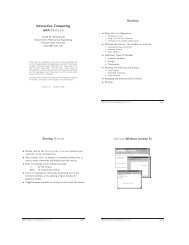"O Soul, Come Back!" A Study in The Changing Conceptions of The ...
"O Soul, Come Back!" A Study in The Changing Conceptions of The ...
"O Soul, Come Back!" A Study in The Changing Conceptions of The ...
You also want an ePaper? Increase the reach of your titles
YUMPU automatically turns print PDFs into web optimized ePapers that Google loves.
364 YING-SHIH YUHo-shang Commentary on the Lao Tzu t=-?fiI, a popular Taoist text<strong>of</strong> Han orig<strong>in</strong>.' For the same reason, the T'ai-p'<strong>in</strong>g ch<strong>in</strong>g tK H isalso an <strong>in</strong>dispensable source for the study <strong>of</strong> popular beliefs concern<strong>in</strong>gthe afterlife at the end <strong>of</strong> the Han period. Portions <strong>of</strong> this textare clearly traceable to the Han times and can throw important newlight on our subject, especially when they are used with caution and<strong>in</strong> comb<strong>in</strong>ation with other newly discovered documents <strong>of</strong> provenHan date.2F<strong>in</strong>ally, a word about the problem <strong>of</strong> cultural unity or diversity isalso <strong>in</strong> order. <strong>The</strong> general picture presented below reflects what allour evidence tells us, but no claim is made that the beliefs describedconstitute <strong>in</strong> any strict sense a unified belief system, much less theonly one, embraced by all the Ch<strong>in</strong>ese <strong>of</strong> the Han empirethroughout the four centuries <strong>of</strong> its existence. Some <strong>of</strong> the beliefsand practices discussed <strong>in</strong> this study may well have been <strong>of</strong> onlylocal sub-cultural importance. But, on the other hand, it would notbe worthwhile to attempt to identify every belief or practice with theregional culture from which it orig<strong>in</strong>ally arose. For example, theidea <strong>of</strong> hun, though possibly <strong>of</strong> a southern orig<strong>in</strong>, had alreadybecome universally accepted by the Ch<strong>in</strong>ese by the third centuryB.C. at the latest, and the T'ai-shan cult had also assumed a nationwidereligious significance by the second century A.D. if not earlier.Throughout this study I shall identify, whenever possible, the dateand local orig<strong>in</strong> <strong>of</strong> each piece <strong>of</strong> support<strong>in</strong>g evidence. However,given our present stage <strong>of</strong> knowledge, it is not always clear whatsorts <strong>of</strong> conclusions can be drawn from such identifications.' This commentary, usually referred to as Lao Tzu Ho-shang chu 9T ??2AJ:, has been traditionallythought to be a post-Han work on account <strong>of</strong> the vulgarity <strong>of</strong> its language. See ChangHs<strong>in</strong>-ch'eng 4R,AA, Wei-shu t'ung-k'ao OYARi&, 2 vols. (Shanghai: Commercial Press,1954), 2:743-45. However, with the discovery <strong>of</strong> several Tun-huang manuscripts <strong>of</strong> earliercommentaries on the Lao Tzu, the orig<strong>in</strong> <strong>of</strong> the Ho-shang text can now be traced to the secondcentury A.D or earlier. SeeJao Tsung-i 7 Lao Tzu Hsiang-erh chu chiao-chien 9tqffis_:R (Hong Kong: by the author, 1956), pp. 87-92 and Kobayashi Masayoshi 'J'itiEr,"Kaj6 sh<strong>in</strong>j<strong>in</strong> shoku no shis6 to seiritsu," / Rih-A, " CD , tR L z, TJhJshakyj IV)5f 65 (May, 1985): 20-43.2 Particularly important are various k<strong>in</strong>ds <strong>of</strong> <strong>in</strong>scriptions found <strong>in</strong> Han tombs. For thedat<strong>in</strong>g <strong>of</strong> the T'ai-p '<strong>in</strong>g ch<strong>in</strong>g, see note 47 below.















